The DeFi market is welcoming a long-awaited wave of 'veteran resurgence'.
As of now, the total locked value (TVL) in the DeFi market has climbed to $197 billion, just a step away from the historical high of $206 billion. More critically, the leader of this rebound is not a newly emerged project, but a group of 'veterans' that once shone brightly during the DeFi Summer.
From the earliest speculative demand to the current 'old tree reviving'. Behind the collective growth of the DeFi market is the accelerated entry of institutional capital (RWA, compliant lending, 401k crypto investments), the rebound in retail demand for on-chain yields during the bull market, and new use cases brought by technological iterations. The veterans' return reflects market confidence and serves as a prelude to a new round of competition in DeFi.
BlockBeats has compiled the main reasons for the soaring prices and TVL of recent DeFi 'veteran players' like Aave, Uniswap, Euler, Pendle, Fluid, and Spark in this article.
AERO: A violent rebound under Coinbase's support.
Aerodrome Finance (AERO) is a decentralized exchange (DEX) born in 2023 and deployed on the Base chain, operating with an automated market-making (AMM) model, combining vote-lock governance and a strong liquidity incentive mechanism. It adopts a highly community-friendly design, with an anonymous team that has not received venture capital and no private placement lock-up, maximizing the binding of interests with users. In just 72 hours after launch, it achieved a financial TVL exceeding $200 million, and subsequently surpassed $1 billion in total trading volume in 2024, with the Slipstream feature contributing 85% of that volume. As of June 2025, AERO's cumulative trading volume has exceeded $100 billion, firmly establishing its core position in the Base DeFi ecosystem.
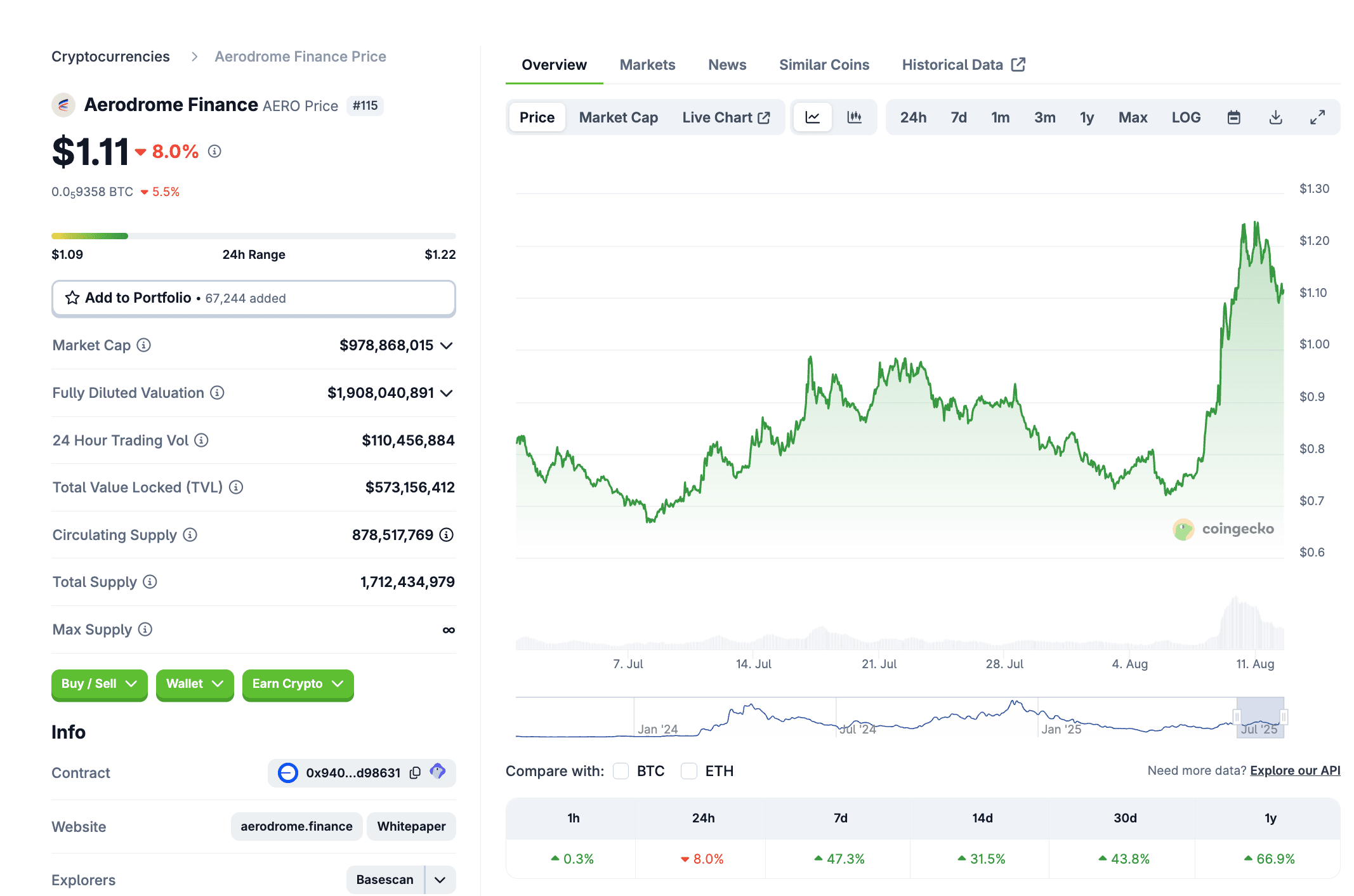
Recently, AERO has shown strong upward momentum: on August 9, stimulated by the news of Coinbase's local DEX functionality launch, AERO rose for consecutive days, once reaching $1.23, with a 7-day increase of about 47%. Its current market capitalization is about $978 million, making it a popular project currency recently.
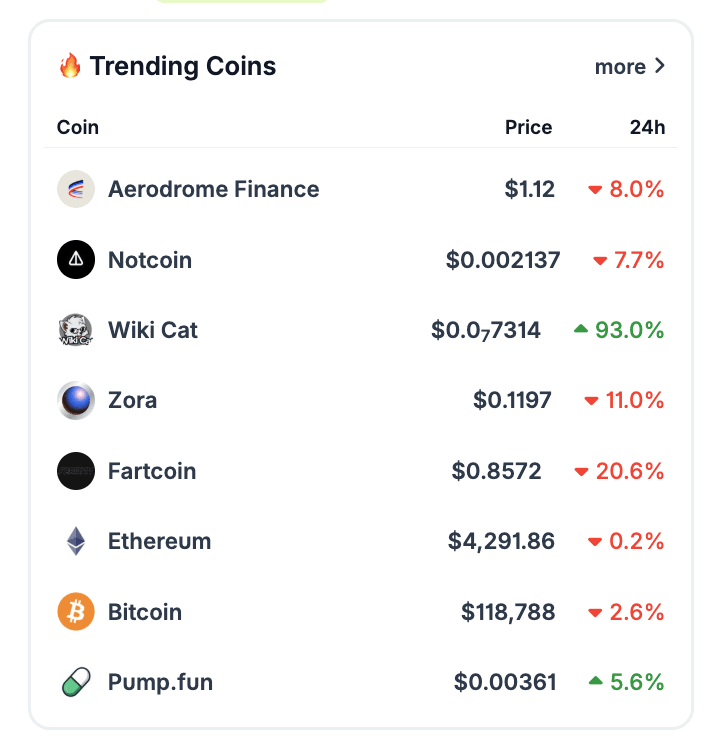
In addition to Coinbase integrating DEX trading functionality for Base's local assets in its app, Aerodrome has become one of the first supported targets. Additionally, AERO's rise may also be attributed to the launch of the 'Pool Launcher' tool, which allows projects to create liquidity pools and earn related trading fees, attracting more Base local projects to join the ecosystem.
Currently, Aerodrome's TVL is about $580 million, nearly all from the Base chain. The 24-hour DEX trading volume is nearly $950 million, and the total trading volume over the past 30 days reached $20.5 billion. In terms of income and investment, Aerodrome's annualized fee income is expected to be about $193 million, with about $15.85 million in income over the past 30 days. Reward incentive expenditures have accumulated to $706 million, indicating a strong liquidity incentive orientation.
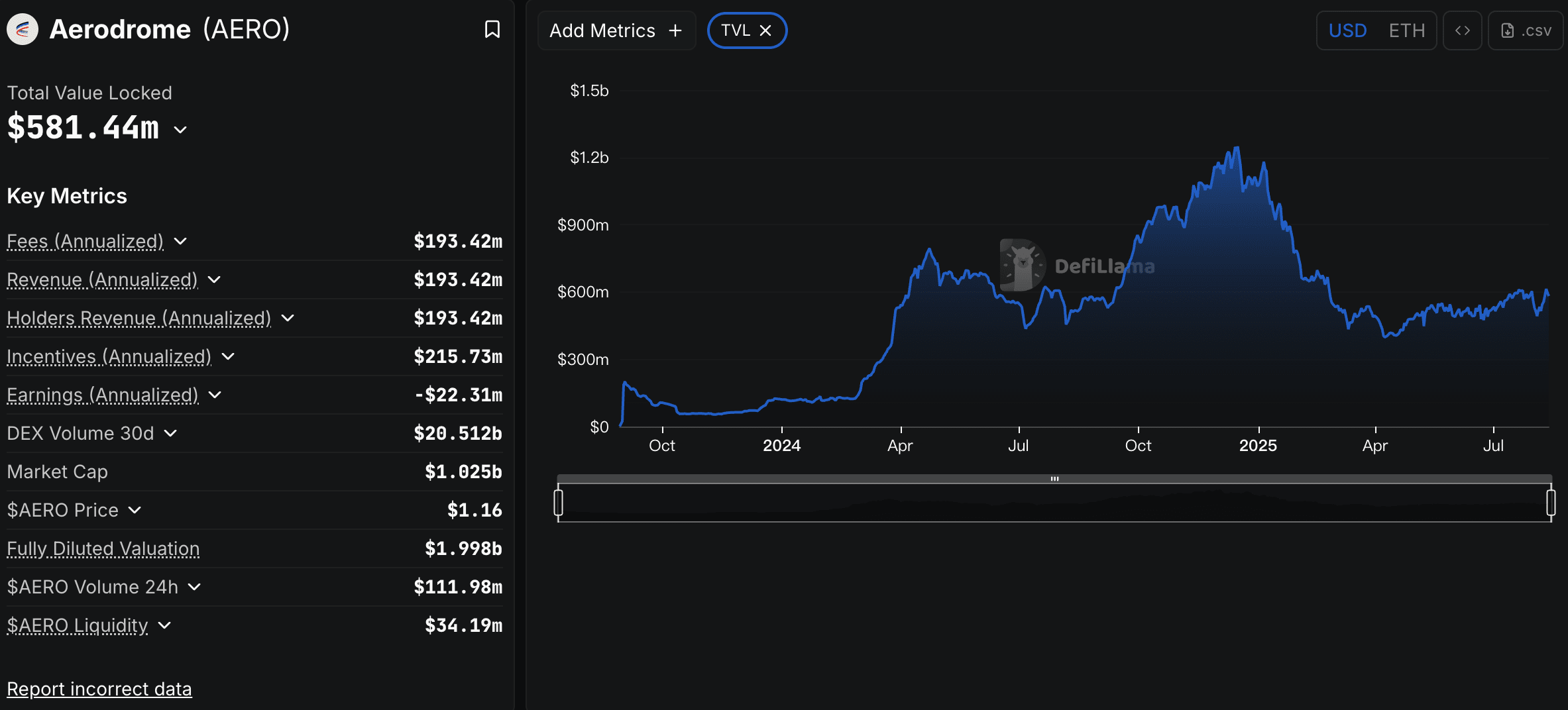
Currently, Aerodrome has built a leading trading and incentive mechanism on the Base chain, becoming a liquidity hub for DeFi. The connection with Coinbase has opened a window for it to reach a broader user base, serving as a detonator for the concentration explosion of capital and liquidity.
Although the upward trend is evident, high incentive expenditures and overheated technical indicators suggest caution against adjustments in the short term. In the medium to long term, attention can be paid to whether its ecological expansion continues, whether cooperative projects land, and whether Coinbase continues to expand its support range, which will determine whether it can return to historical highs ($2.32) or continue to break through.
Fluid Flip's ambition to surpass Uniswap.
Fluid is a DeFi protocol that integrates DEX (decentralized exchange), lending, and vault systems, achieving high capital efficiency and liquidity reuse through its innovative Liquidity Layer. Launched on Instadapp and reintroduced in 2023, Fluid allows assets to switch uses freely within the liquidity layer without multiple lock-ups, significantly reducing fragmentation costs and enhancing yields. Its Smart Debt and Smart Collateral models provide better capital efficiency for liquidity providers and debtors.
In the recent DeFi market, Fluid has become one of the focal points: on August 4, Fluid's daily on-chain trading volume once surpassed Uniswap, reaching about $1.5 billion, driving the price of $FLUID up 14.4% that day. As of now, Fluid has risen to $7.38, with a 36.1% increase in 7 days and a 51% increase in 30 days.

The reasons for Fluid's rise may include the following four points:
1. Liquidity layer architecture breaks fragmentation.
Fluid is launching on chains like Arbitrum and Solana, introducing a lighter Lite version while supporting DEX v2 upgrades, which helps further increase yields and user coverage. Moreover, Fluid's Liquidity Layer enables liquidity sharing, allowing assets to meet multiple usage needs with a single lock-up, which is the core driving force behind its rapid absorption of funds and trading.
2. Rapid increase in trading share: In a short time, Fluid surpassed Uniswap, capturing over half of the stablecoin trading market, directly strengthening its ecological and emotional dual drive.
3. Trader confidence rebounds: DEX daily trading volume reaches an all-time high, token prices rise in the short term, indicating an increase in market recognition of the Fluid model, with liquidity allocation efficiency being affirmed.
4. The long-term favorable expectations of the buyback mechanism: Officials have made it clear that when annual income reaches $10 million, the buyback will be initiated, providing medium to long-term support for token value and attracting investors to position themselves during low-price phases.
The platform's cumulative trading volume has exceeded $7.9–$8 billion, with a monthly growth rate of TVL of about 27% and a total value of approximately $838 million, showing a strong trend of capital growth. Since 2025, Fluid's deposits have grown nearly 40%, exceeding $1.4 billion, and it has expanded multi-chain layouts (such as Arbitrum, Solana) and DEX Lite planning. As of August 3, Fluid's market share in stablecoin swaps on Ethereum, Base, Arbitrum, and Polygon reached 55.5%, far exceeding Uniswap (25.7%) and Curve (13.4%).
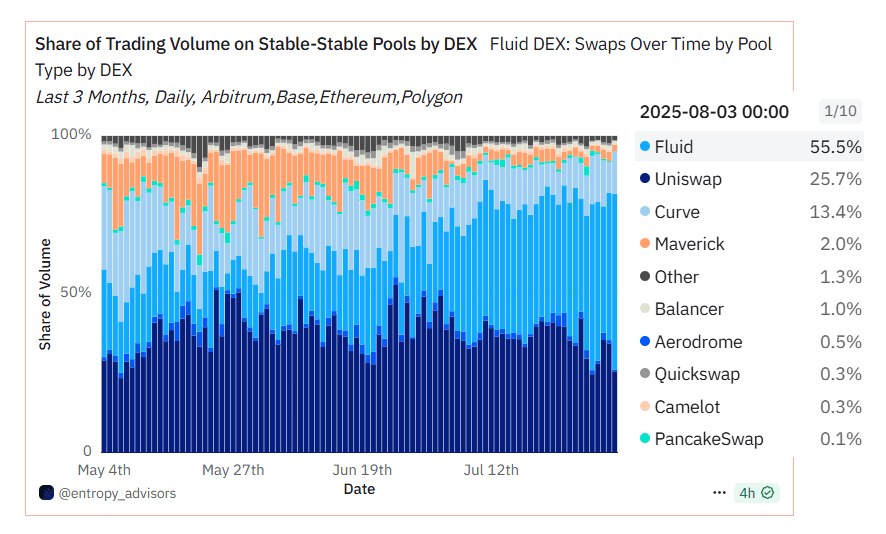
In summary, Fluid has become the 'new force' of DeFi: through its unique Liquidity Layer, strong transaction data, and multi-chain expansion strategy, it has rapidly brought the platform back to the center stage and set a new benchmark for stablecoin trading in DeFi. The short-term performance is remarkable, but several risk points still need attention: whether FLUID will experience short-term adjustments remains to be observed; the ecological landing and user stickiness, whether subsequent projects can truly build on Fluid's liquidity layer, is the key to sustained momentum. If the subsequent DEX v2 and Lite versions can land smoothly and drive revenue past critical nodes, it could not only initiate the buyback mechanism, but also further enhance user stickiness and market valuation, helping Fluid become a new benchmark for stablecoin trading.
Uniswap v4 TVL breaks $1 billion again.
Uniswap is a 'veteran' of the DeFi world, with its v4 version officially launched at the beginning of 2025, including 12 chains such as Ethereum, Arbitrum, Base, Polygon, BNB Chain, and Unichain. The new 'Hooks' feature allows liquidity pools to have dynamic rates, on-chain limit orders, TWAP, and other custom logic, while reducing gas costs by over 99% through Singleton architecture and Flash Accounting technology. v4 retains the capital efficiency advantages of v3 while enhancing flexibility and programmability, becoming an important part of DeFi's innovative infrastructure.
Recently, Uniswap's performance has been steady: as of now, UNI's price is $11.27, having risen about 31% in the past 30 days, with market capitalization back above $670 million.

The reasons for UNI's rise include:
1. Strong TVL rebound: v4 has astonishingly crossed $1B TVL, providing solid emotional support for UNI's price and highlighting the warming trend in the DeFi ecosystem.
2. Hooks innovation attracts capital: programmable liquidity strategies enable various strategy projects (such as Bunni, EulerSwap) to rise rapidly, driving user participation and operational depth.
3. The prominent role of Unichain expansion: the addition of new networks brings lower costs and efficient experiences, creating a new growth engine for Uniswap and further enhancing activity.
4. Technical iteration and institutional upgrade: v4 introduces smart wallet support, cross-chain integration (such as Hyperbridge, LayerZero), and over 640 million swap transaction volumes, building a more comprehensive trading infrastructure.

Currently, Uniswap v4 TVL has surpassed the $1 billion milestone. In terms of cumulative trading volume, Uniswap has exceeded $11 billion, making it the liquidity hub of DeFi. Among them, Unichain accounts for about 75% of daily trading volume, while Ethereum accounts for about 15–20%. In terms of Hooks deployment, over 2,500 Hook liquidity pools have gone live, with cumulative trading volumes for both Bunni and EulerSwap exceeding $1 billion.
Although Fluid shines brightly in the market, Uniswap remains a stable powerhouse: its v4 version continues to consolidate its core position in DeFi through technological innovation and ecological expansion. Rapid growth in TVL and a rich application of Hooks are important foundations for its revival. However, technical indicators like RSI are high, and it may face some profit-taking pressure in the short term.
Whether it can continue to rise depends on: whether the Hook strategy pool can bring new growth; whether cross-chain integration deepens ecological cooperation; whether Unichain can continue to maintain cost advantages and attractiveness, with hopes of challenging the $13–$14 range.
Euler: 'Rebirth from the ashes' after the hacker attack.
Euler Finance is a modular lending protocol on Ethereum, known for its risk layering, flexible asset permissions, and high capital efficiency. It supports access to any ERC-20 asset, manages leveraged positions, and has a complex liquidation protection mechanism. After being heavily impacted by a hacking incident in 2024, the project quickly rebooted and regained 'trust high ground', becoming one of the core projects in the resurgence of DeFi lending.
Recently, $EUL reached an all-time high, with the price briefly surpassing $15, increasing more than 950% from the low point at the end of 2023. The market capitalization also approached $300 million. Although there has been a slight pullback, the current price stabilizes in the range of $11.8–$13.
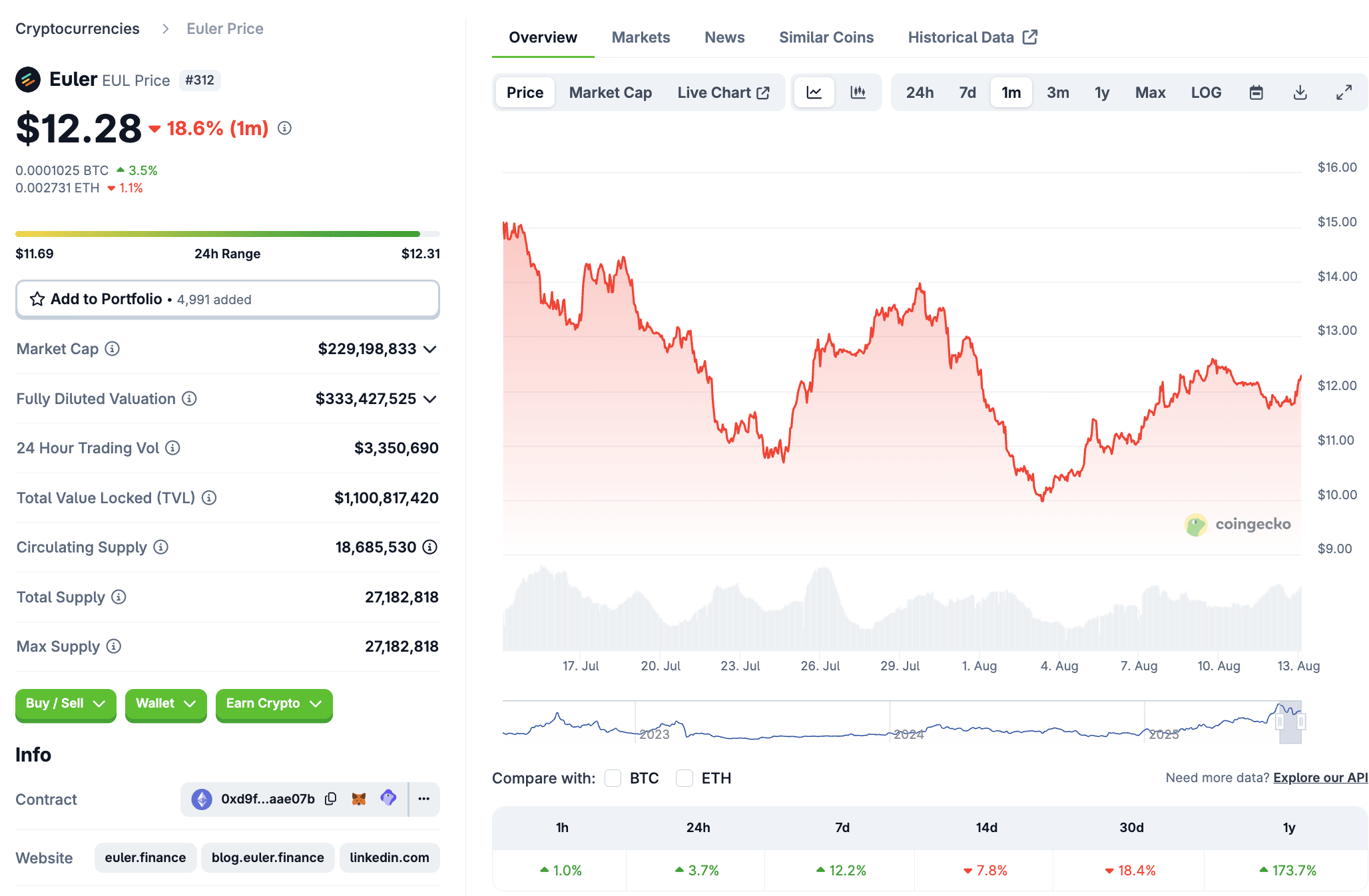
The reasons for Euler's rise include:
1. Rebirth from the ashes: Euler quickly rebooted after the hacking incident, winning community trust and capital inflow, which is an important foundation for its significant rebound.
2. TVL and lending depth both rebound: abnormal growth in TVL and a surge in active loans reflect strong user demand for lending and a recovery in protocol momentum.
3. EulerSwap complements the ecology: after launching its native DEX, Euler has built a self-circulating liquidity path, enabling staking, lending, and trading to achieve closed-loop linkage.
4. Support from mainstream platforms: Recent news indicates that Coinbase will support EUL. After the announcement, the price surged about 5.7% in one day, reflecting an increased recognition from the capital market.
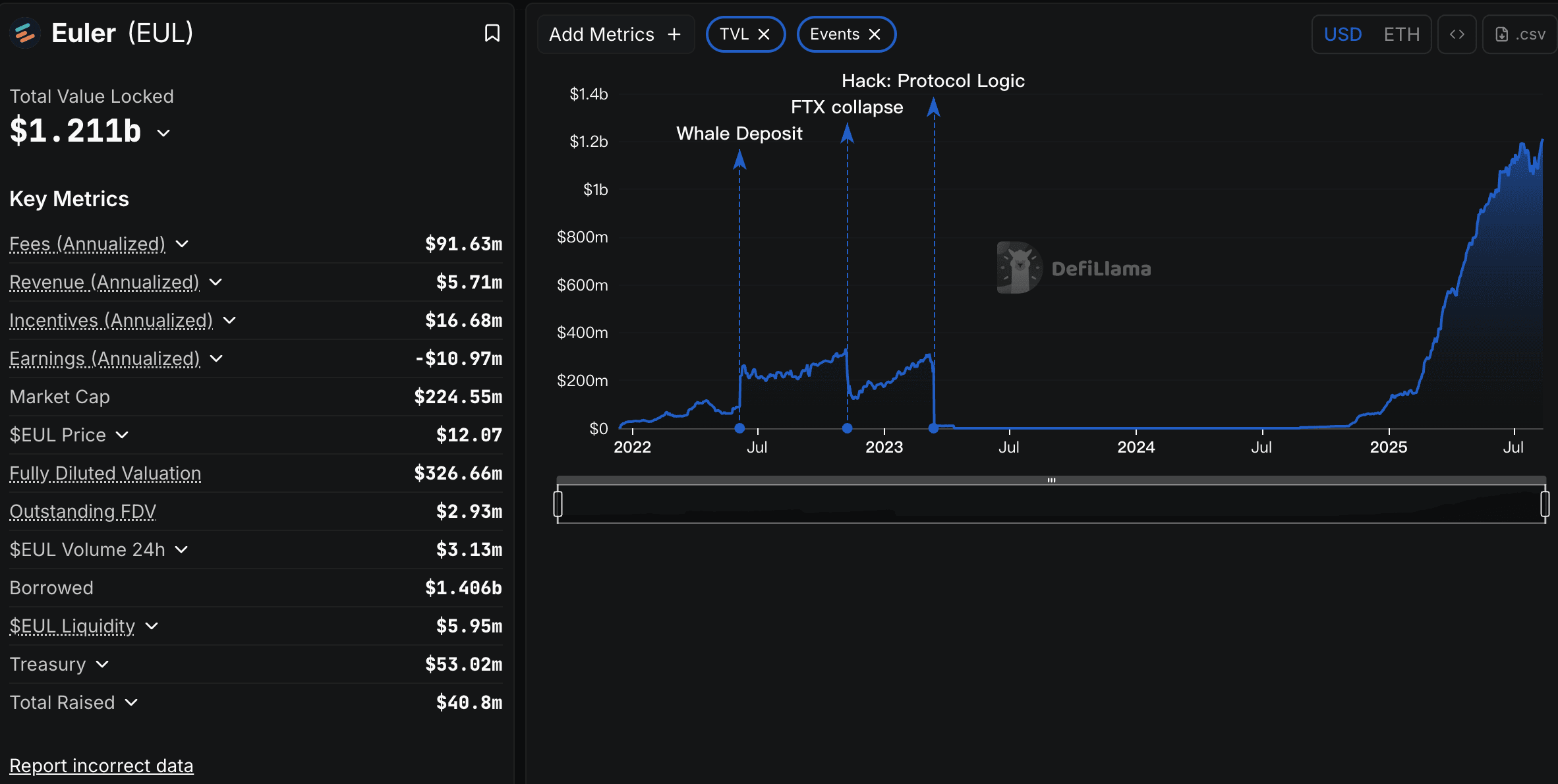
Latest data shows that Euler's TVL has reached $1.2 billion, having basically overcome the impact and challenges following the hacking incident. Euler launched its native DEX—EulerSwap, which has seen cumulative trading volume exceed $1 billion since its launch in May. Lending activity: the amount of active loans recently surpassed $1 billion, whereas at the end of 2024, it was only about $240,000, showing significant growth.
Euler's recovery is a typical 'rebirth from the ashes' story: from the plight after being hacked, to a rapid restart, explosive TVL growth, product innovation, and gradually restoring market value and attention, demonstrating the resilience of old DeFi projects in trust and governance.
But worth noting is: the pullback pressure after high prices; and whether EulerSwap can maintain trading depth and whether the lending categories will expand, which will determine whether it can sustain growth; whether there will be more capital platforms that continue to support it, such as deeper support from Coinbase and more CEX listings, will enhance liquidity and market capitalization foundation. If Euler can indeed maintain TVL growth, lending activity, and DEX building momentum in the future, it is expected to return to a higher valuation range and continue to write the classic chapter of 'the old tree reviving'.
Pendle: Driven by Boros, both TVL and price soar.
Pendle is a DeFi protocol that allows users to 'trade future yields.' Its core mechanism splits any yield-bearing asset into 'yield certificates' and 'principal certificates,' allowing users to freely trade future yields. Pendle V3 introduces the Boros platform, creating advanced yield trading tools and has become one of the core infrastructures for yield trading.
Pendle has recently performed brilliantly: the price once rushed to $6, with a weekly increase of up to 46%, far exceeding the overall market trend.
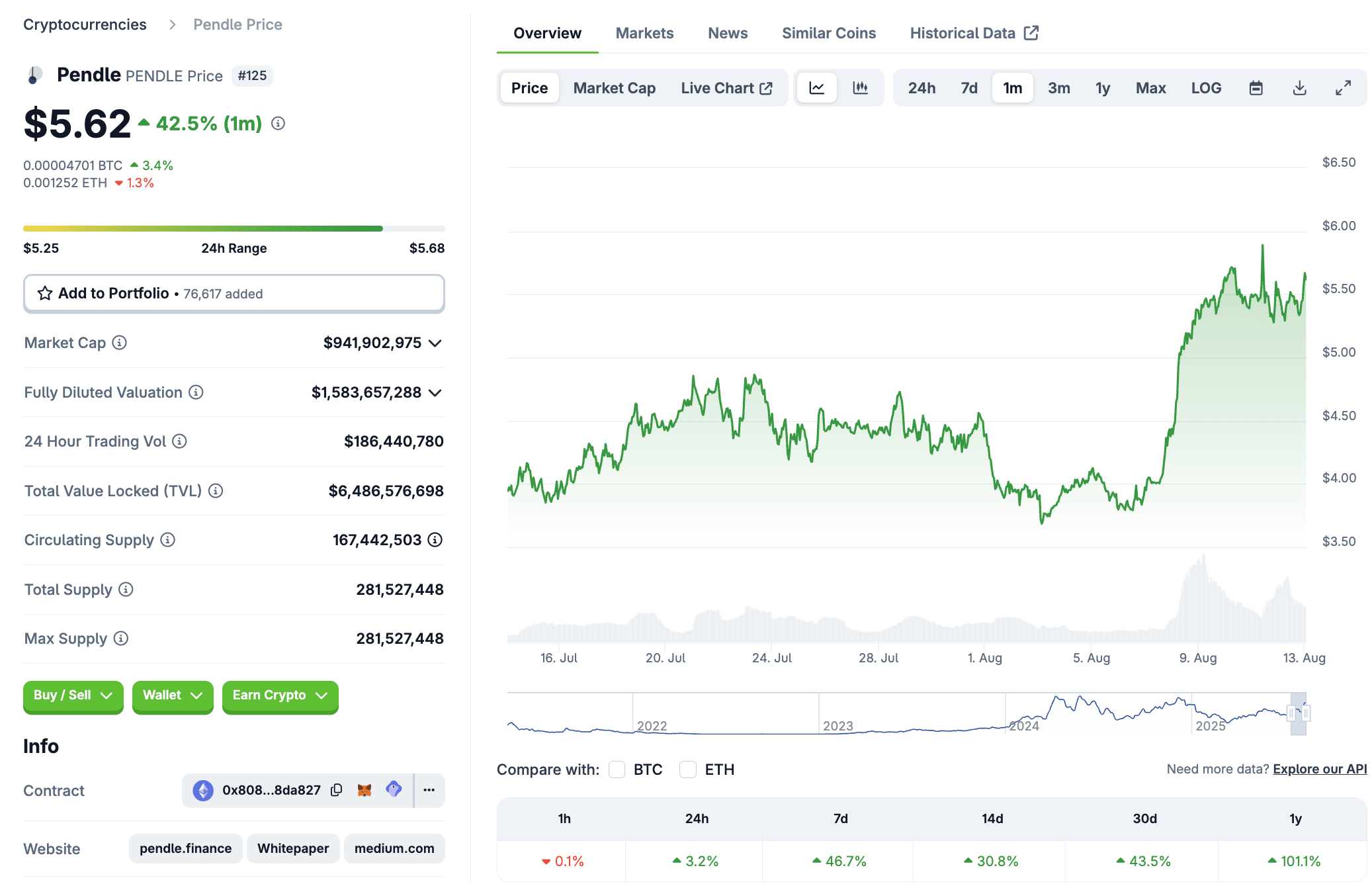
The reasons for Pendle's rise include:
1. Yield trading platform: The Boros engine launched by Boros converts BTC/ETH funding rates into tradable assets (Yield Units), rapidly enhancing user participation and capital inflow.
2. Cross-protocol integration mechanism optimizes capital efficiency: The cross-ecological linkage with Ethena, Aave, and Boros makes Pendle a gathering place for efficient yield strategies, and its PT-USDe strategy drives an increase in capital scale.
3. TVL and yield growth bring confidence enhancement: record high TVL and income surges provide strong support for tokens and enhance market sentiment.
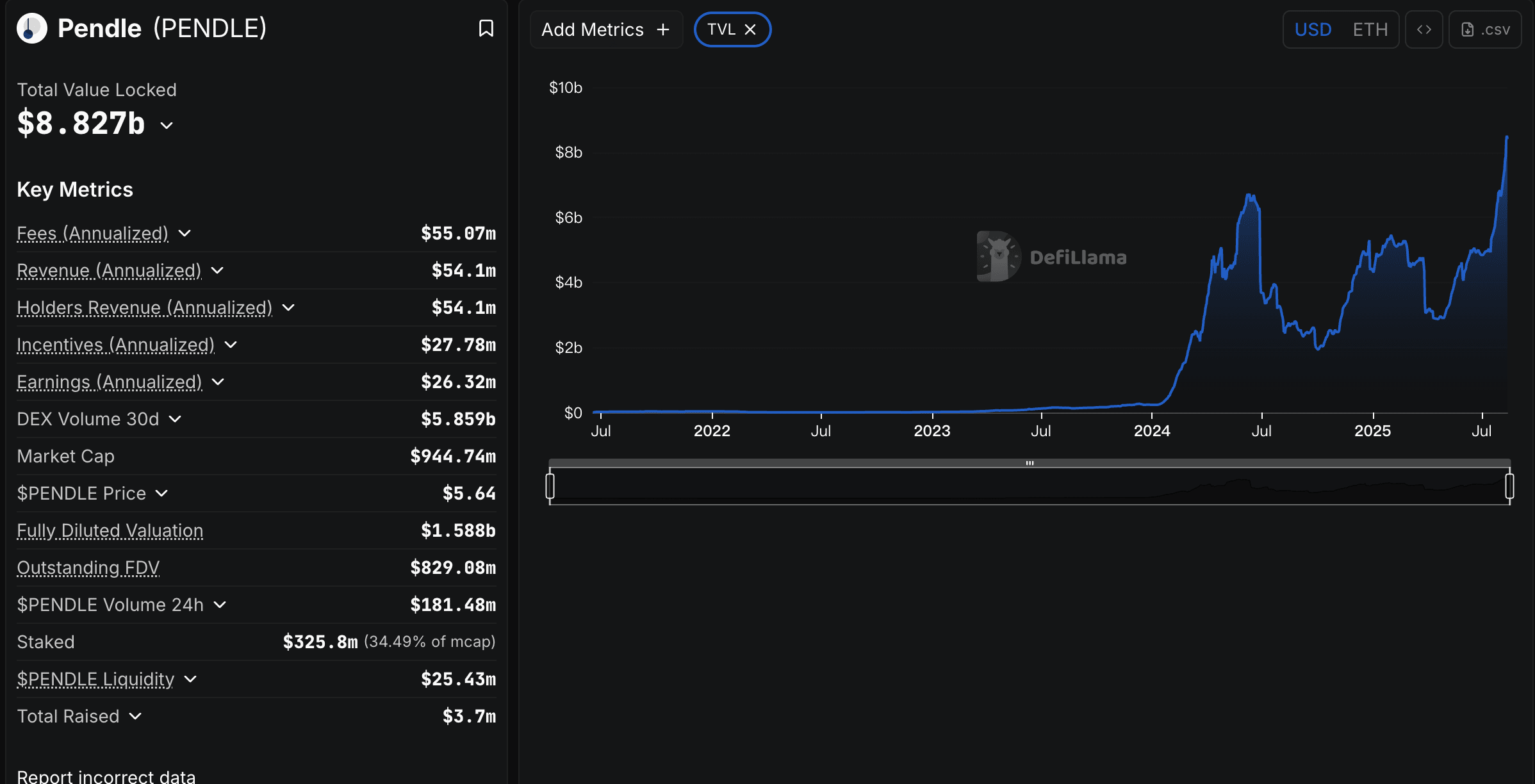
In core data, Pendle's TVL reached a historical high of $8.8 billion, mainly driven by capital explosion from the Boros platform. In the first two days after launch, over $1.85 million in BTC and ETH was deposited, and the number of active addresses for Pendle on Arbitrum doubled, attracting attention from both on-chain and institutional investors.
At the same time, protocol integration drives liquidity explosion. About 60% of TVL comes from USDe strategies (such as PT-USDe generating leverage and liquidity on Aave), creating a strong 'yield-loop' asset recycling mechanism.
Pendle is becoming a new windfall in DeFi due to its unique yield trading mechanism and protocol integration strategy: the Boros platform injects strong momentum, leading to a dual explosion in TVL and price. However, caution is needed regarding short-term technical high pullback risks and concentration risks brought by USDe's exclusivity. If Pendle can continue to expand Boros-supported assets (such as staking yields and government bond yields) and promote overall protocol governance and ecological deep integration, it holds significant potential to challenge the $7–$8 range continuously, moving towards a true 'new chapter for an old project'.
The king of lending is crowned again, Aave is gradually institutionalized.
Aave is the top lending protocol in the DeFi world, known for its non-custodial, modular design and cross-chain support. Its launched GHO stablecoin, Umbrella security mechanism, and Aave Arc/Horizon and other innovative features further consolidate its core position in the DeFi liquidity layer.
Recently, AAVE has performed brilliantly: the price surged to a high of $330 in mid-July, rising approximately 24% in 7 days. Although there is short-term pullback pressure at the high market price, the overall trend remains strong.
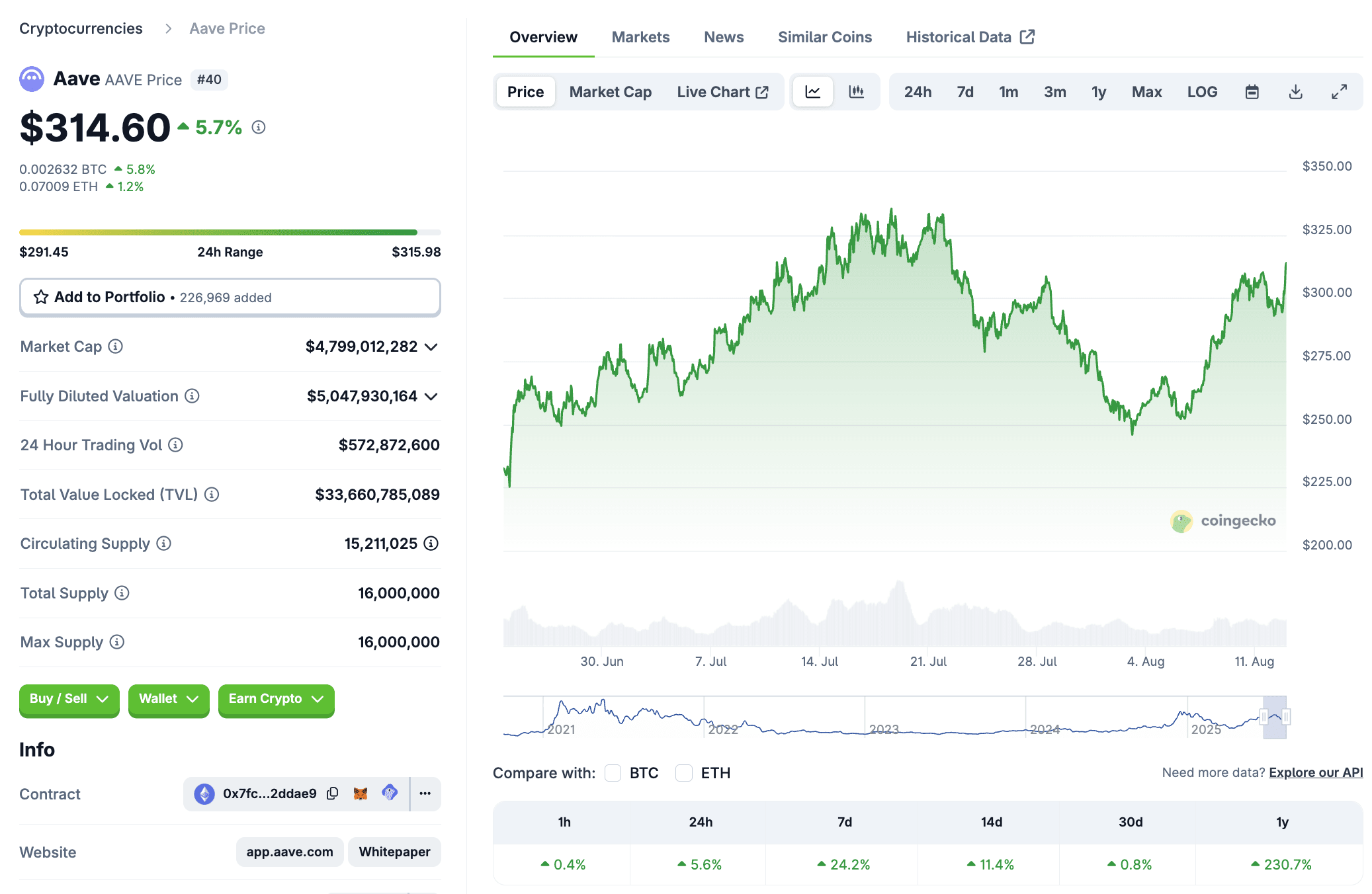
The reasons for Aave's rise include:
1. Capital inflow and leading TVL: Aave remains dominant in the lending market, with new users and capital continuously flowing in, providing a solid foundation for market confidence.
2. Stablecoin GHO performance enhancement values recognition: GHO's cross-chain expansion, sGHO, anti-GHO, and other mechanisms provide multi-layered yield incentives for holders, enhancing ecological stickiness.
3. Institutional paths continue to land: Horizon, Arc, and KYC compliance mechanisms make Aave an important entry point for institutional-level DeFi lending.
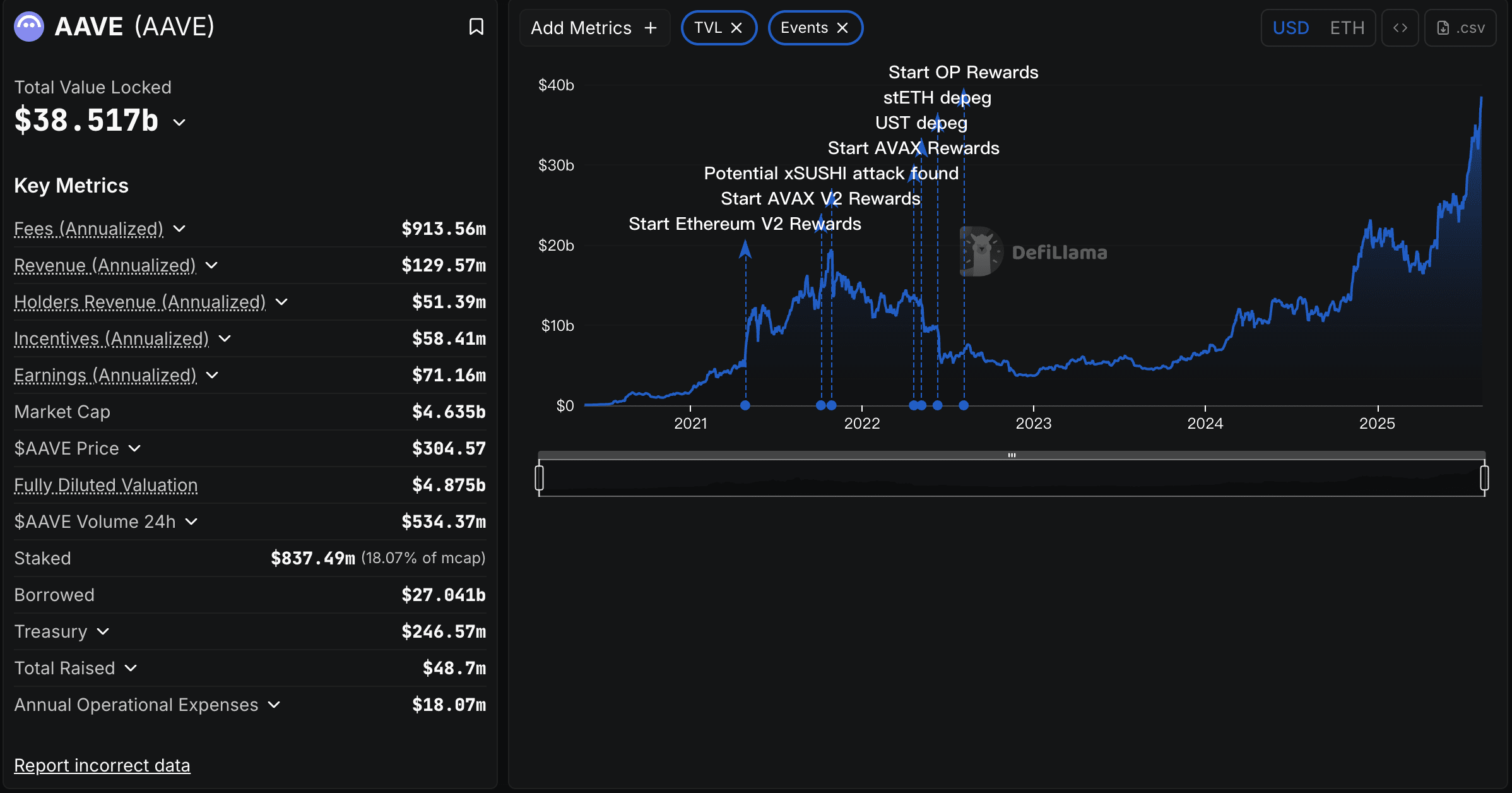
From other core data, Aave's TVL currently stands at $38.04 billion, an increase of 52% since the beginning of the year, accounting for nearly a quarter of the total DeFi TVL and dominating the lending market. Its native stablecoin GHO has a circulation of $312 million, and the cross-chain expansion of GHO on Arbitrum and Base promotes income growth. AAVE's return rate in the most recent rebalance period reached 22.97%.
In terms of specific institutional cooperation, Aave has launched the Horizon project to promote RWA and institutional usage paths; it has partnered with Plasma to launch a blockchain fund for institutions; Aave DAO has also approved a white-label plan for the Kraken Ink chain.
As a 'veteran' in the DeFi lending field, Aave remains 'old but strong': TVL and deposit scales continue to set records, the functionality of GHO continues to expand, and the institutional path progresses steadily, all injecting strong momentum into its resurgence. However, AAVE faces pullback pressure at high prices, with technical indicators like RSI nearing overbought, and may need to adjust in the short term. Whether it can continue to lead the DeFi lending field in the future depends on the launch progress of Aave V4, the landing effect of RWA channels, and regulatory trends.
Spark: A sword from MakerDAO.
Spark Protocol (referred to as Spark) evolved from MakerDAO and is now part of the Sky ecosystem. It is a high-level on-chain capital allocator dedicated to efficiently deploying multi-hundred million dollar stablecoin capital into DeFi, CeFi, and RWA (real-world assets). Its core products include SparkLend (lending), Spark Savings (yield generation), and Spark Liquidity Layer (cross-chain liquidity allocation), among others.
Since the SPK token was officially airdropped and listed on June 17, 2025, its market performance has been eye-catching: the original TGE issue price was about $0.065, and in a short time, the SPK price experienced significant fluctuations—falling to less than half of the issue price (about $0.03), but then rebounded strongly, reaching an all-time high of $0.18 on July 23, with an increase of over 400%. The current price stabilizes in the range of $0.12–$0.13, with a market capitalization close to $190 million and a 24-hour trading volume rising to nearly $450 million.
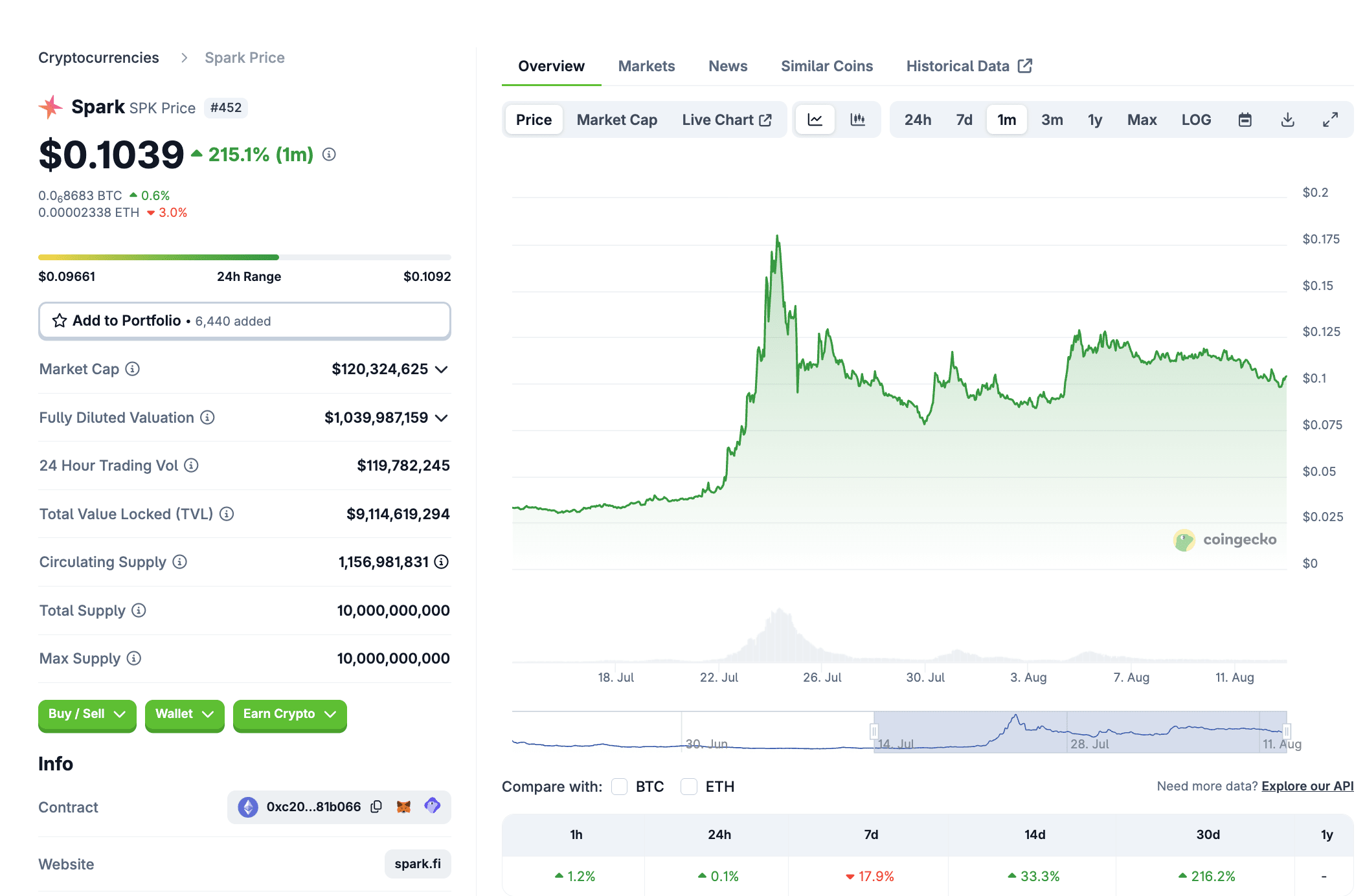
The main reasons for the rise of the SPK token may include the following four:
1. TVL explosion boosts sentiment recovery: Since April, Spark's TVL has surged by 250%, and such capital infusion has directly driven market confidence, rapidly pushing SPK's price back up and setting an ATH.
2. Airdrops and listings spur trading: Spark launched with large-scale airdrops and listings on mainstream exchanges (such as Binance), establishing favorable mechanisms that boosted initial market attention and price volatility.
3. Top-tier funding and technology backing, with a $6.5 billion stablecoin reserve backed by the Sky (formerly MakerDAO) platform, and a capital deployment core based on transparency mechanisms, giving Spark a strong stable state.
4. Product structure integrity: Spark has a product matrix covering yield generation, lending, and cross-chain liquidity, fully connecting user needs through SparkLend, Savings, and SLL.
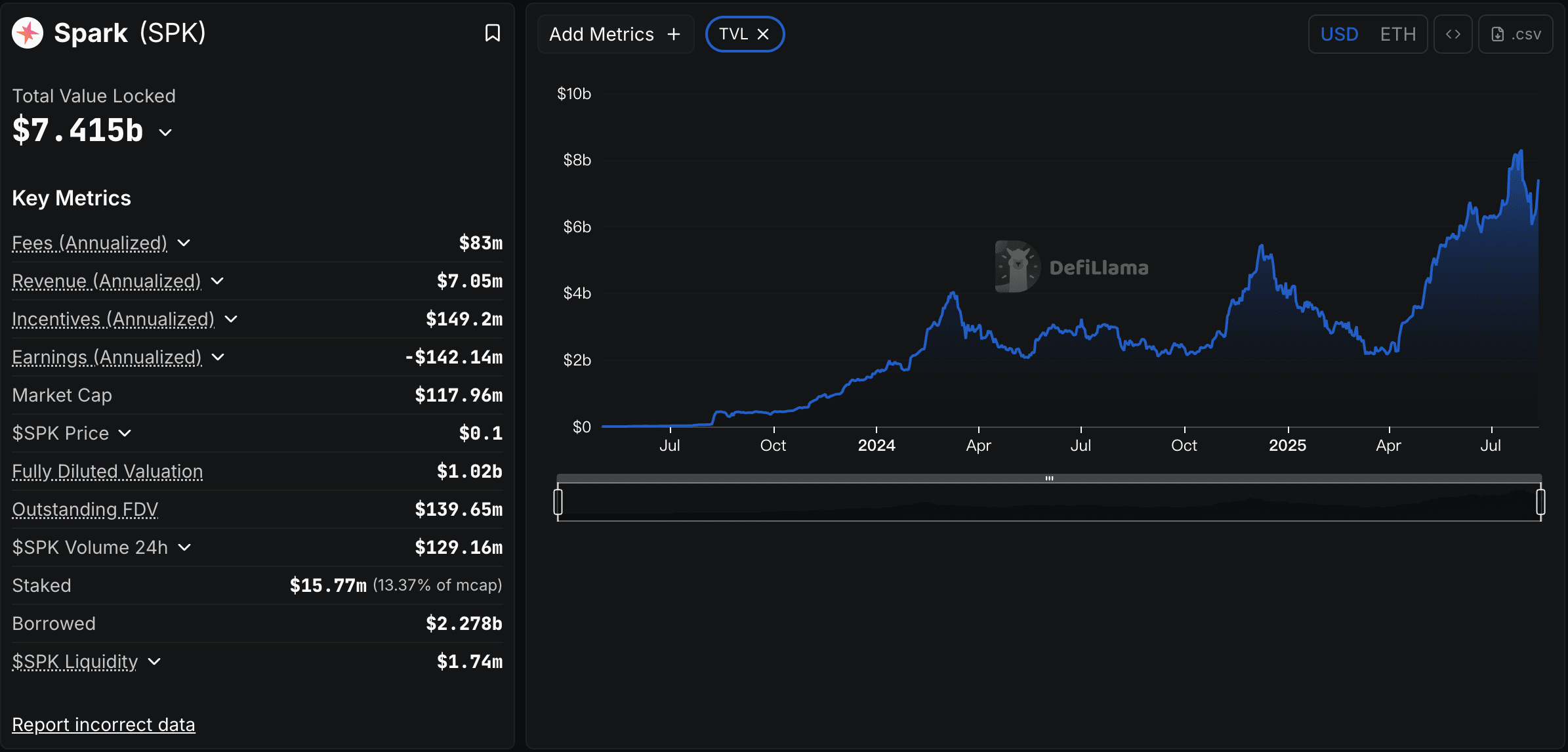
As of the time of writing, Spark's total TVL reached $7.4 billion. Previously, in July, the TVL had reached a peak of $8.1 billion, ranking as the sixth-largest platform in DeFi, with SparkLend managing about $4.7 billion and SLL managing about $3.4 billion. Spark is rapidly reshaping the standards for stablecoins and capital efficiency in DeFi, with the explosive growth of TVL, airdrop sentiment, and Sky's endorsement resonating together, allowing SPK to achieve a legendary return of 'new life for an old project' in the short term.
However, at the same time, high volatility and initial cash-out pressure remain, with prices currently having fallen by 30-40%, and short-term caution is needed against market adjustments. Whether it can continue to strengthen in the future will depend on whether the Spark ecosystem can continue to expand (such as CeFi channels, RWA integration), governance activity, and SPK holders' loyalty performance.
